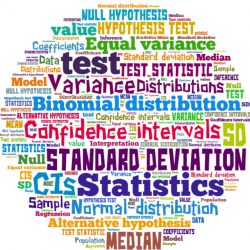
Whether it's in class or during data collection for research, remember the basic principles of statistics no matter which statistical test you are learning or applying:
You are testing a hypothesis by collecting data.
Data only supports or fails to support your hypothesis.
Design all experiments and begin every test by writing out your null and your alternative hypothesis.
Statistical analyses always begin by assuming that your experimental treatment has no effect on your population, and all results are due to chance. This is called the null hypothesis and serves as your starting point. All statistical analyses are designed to support or reject the null.
There are limitations to every sampling method.
You cannot accurately capture the response of every individual that ever existed, so you must take a sample. Sample results will vary due to many things. This is called variability and it can be quantified.
Statistics measure the amount of variability and compare it to the mean of all samples.
Some variability is due to errors introduced by your sampling method, some to random chance (ie. by chance you sampled more of one type of individual). The first step in statistical analysis is to quantify the amount of each type of variability.
Your statistical tests measure the probability that you will randomly get the same results without an experimental treatment.
This is the p value. High p values mean there is a high chance your data represents a random pattern unrelated to your experiment (ie. p = 0.9 or 90% of the variability is due to chance). Set the amount you are willing to accept, or the α, and compare this to the p value generated by your test to accept or reject your null hypothesis.
See our Trident Workshop on Statistical analysis for details!
Learn more about the online degree programs that Trident offers.
Dr. Tanya Murray is Trident's General Education Program Director and oversees all of the University's science courses.

